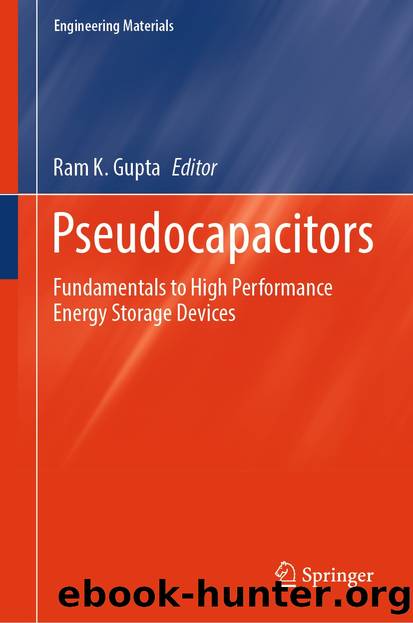Pseudocapacitors by Unknown

Author:Unknown
Language: eng
Format: epub
ISBN: 9783031454301
Publisher: Springer Nature Switzerland
2.2 MXenes/polymer Composites
Compared with other pseudocapacitive materials, conductive polymers exhibit additional advantages in supercapacitors due to simple synthesis, good conductivity, good flexibility, and high redox activity [12]. Many conductive polymers can achieve high capacitance in acidic electrolytes, as can MXenes/conductive polymer composites. At present, many conductive polymers, such as polyaniline (PANI), poly (3,4-ethylenedioxythiophene) (PEDOT), polypyridine (PPy), and polydopamine (PDA), combine with MXenes to prepare composites with excellent electrochemical performance [12]. Gogotsi et al. prepared a high-performance 3D PANI@M-Ti3C2Tx composites by casting homogeneous polyaniline layer on 3D porous Ti3C2Tx MXene in Fig. 5aâb [37]. The compact and highly integrated PANI@MXene heterostructure possesses a larger work function, so they have high anodic oxidation electrochemical stability and can be used as stable positive terminals. This electrode synergistically utilizes the high capacitance of PANI at a positive potential and the high-speed capability of MXene, which allows the PANI@M-Ti3C2Tx electrode to have a high specific capacitance of 1632 F/cm3, and a high-capacity retention of 827 F/cm3 at a scanning rate of up to 5000 mV/s in Fig. 5c. The asymmetric supercapacitors device assembled based on this material achieves a volumetric energy density of 50.6Wh/L. Yuan et al. proposed high conductivity PANI nanoparticles (PANI-NPs, ~10 nm) as intercalation agents, and adjusted MXene nanoflake interlayer by self-assembly method [38]. PANI-NPs not only inhibit the self-stacking of MXene, but also provides more ion transfer pathways. In addition, conductive PANI-NPs filled between MXene layers can construct interconnected conductive channels in the form of nanoparticles. Meanwhile, PANI-NPs will slightly change the thickness of the MX/PANI-NPs mixed film, resulting in higher volumetric capacitance. The capacitance of the MX/PANI NPs-10% electrode is 1885 mF/cm2 (377 F/g), which can maintain a high capacitance of 873 F/cm3 even when the MXene load reaches 5 mg/cm2. In addition, the symmetrical supercapacitors assembled based on MX/PANI NPs hybrid films have a bulk energy density (20.9 Wh/L). Zhang et al. established a simple and effective method for preparing Ti3C2Tx/PEDOT: PSS hybrid membranes, which involves filtering Ti3C2Tx/Levios PH1000 composite ink, and then treating by H2SO4 in Fig. 5dâe [39]. The process of H2SO4 treatment can remove some insulating PSS on the Ti3C2Tx/PEDOT: PSS hybrid film, thereby significantly improving the conductivity of the composites. In addition, conductive PEDOT can not only serve as a pillar between Ti3C2Tx sheets, exposing more electroactive surfaces and reducing ion diffusion pathways but also serve as a conductive bridge to form multidimensional electron transfer channels for accelerating the electrochemical reaction process. The specific surface area of Ti3C2Tx/PEDOT: PSS (Ti3C2Tx/P-100-H) hybrid film treated with H2SO4 increased by 4.5 times, and the capacity reached 1065 F/cm3 at 2 mV/s, demonstrating excellent rate performance in 1 M H2SO4 electrolyte in Fig. 5f. The asymmetric supercapacitors based on the materials show an energy density of 23mWh/cm3 and a power density of 7659 mW/cm3. Ma et al. prepared MXene/PPy (M-PPy) composite films using MXene nanosheets and PPy nanofibers as raw materials by vacuum-assisted filtration in Fig. 5g [40]. By introducing PPy nanofibers, the layer spacing of MXene nanosheets is expanded in Fig.
Download
This site does not store any files on its server. We only index and link to content provided by other sites. Please contact the content providers to delete copyright contents if any and email us, we'll remove relevant links or contents immediately.
| Automotive | Engineering |
| Transportation |
Whiskies Galore by Ian Buxton(41938)
Introduction to Aircraft Design (Cambridge Aerospace Series) by John P. Fielding(33093)
Small Unmanned Fixed-wing Aircraft Design by Andrew J. Keane Andras Sobester James P. Scanlan & András Sóbester & James P. Scanlan(32764)
Craft Beer for the Homebrewer by Michael Agnew(18197)
Turbulence by E. J. Noyes(7978)
The Complete Stick Figure Physics Tutorials by Allen Sarah(7338)
Kaplan MCAT General Chemistry Review by Kaplan(6900)
The Thirst by Nesbo Jo(6879)
Bad Blood by John Carreyrou(6583)
Modelling of Convective Heat and Mass Transfer in Rotating Flows by Igor V. Shevchuk(6406)
Learning SQL by Alan Beaulieu(6237)
Weapons of Math Destruction by Cathy O'Neil(6215)
Man-made Catastrophes and Risk Information Concealment by Dmitry Chernov & Didier Sornette(5956)
Digital Minimalism by Cal Newport;(5704)
Life 3.0: Being Human in the Age of Artificial Intelligence by Tegmark Max(5516)
iGen by Jean M. Twenge(5385)
Secrets of Antigravity Propulsion: Tesla, UFOs, and Classified Aerospace Technology by Ph.D. Paul A. Laviolette(5333)
Design of Trajectory Optimization Approach for Space Maneuver Vehicle Skip Entry Problems by Runqi Chai & Al Savvaris & Antonios Tsourdos & Senchun Chai(5037)
Pale Blue Dot by Carl Sagan(4954)
